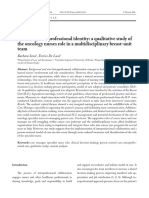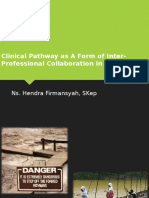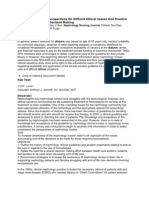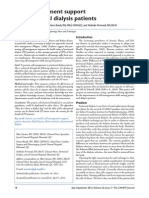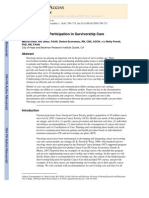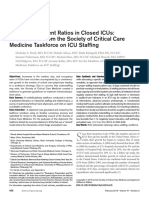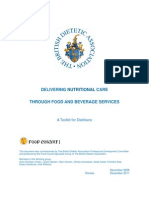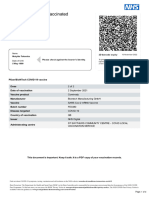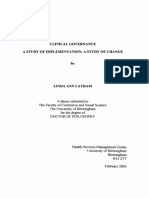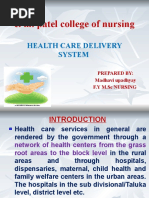Developing A Nurse-Led Holistic Clinic and Assessment Pathway
Developing A Nurse-Led Holistic Clinic and Assessment Pathway
Uploaded by
KenCopyright:
Available Formats
Developing A Nurse-Led Holistic Clinic and Assessment Pathway
Developing A Nurse-Led Holistic Clinic and Assessment Pathway
Uploaded by
KenOriginal Description:
Original Title
Copyright
Available Formats
Share this document
Did you find this document useful?
Is this content inappropriate?
Copyright:
Available Formats
Developing A Nurse-Led Holistic Clinic and Assessment Pathway
Developing A Nurse-Led Holistic Clinic and Assessment Pathway
Uploaded by
KenCopyright:
Available Formats
Feature
Developing a nurse-led holistic
clinic and assessment pathway
A collaboration between a group of clinical nurse specialists and a patient focus
group resulted in the design of a holistic nurse-led framework for the care of
women with gynaecological cancers. Shelagh Roberts and colleagues report
Outcomes in Gynaecological Cancers (DH 1999b) and
Summary
involves eight of the nine specialist nurses.
This article explores the work undertaken by clinical nurse specialists in the Four years ago, to encourage patient involvement
Merseyside and Cheshire Cancer Network with a patient focus group. The purpose in developing service delivery, the CNS group set up a
was to develop a nurse-led holistic clinic and assessment pathway for women who patient focus group. This involves eight to ten women
have had gynaecological cancers. who have had gynaecological cancers. They meet
every six weeks with two members of the CNS group,
Keywords Chris Webster and Shelagh Roberts, and the Liverpool
Gynaecological system and disorders, nurse-led services, patient-centred care Women’s Hospital (LWH) service improvement officer,
Jackie Connell. The meetings offer the chance to
Nurse-led clinics aim to address patients’ discuss subjects relating to patients’ experience of
psychological needs (Maguire and Faulkner 1988, cancer care. Copies of the minutes are forwarded to
Moore 1997, Rogers 2005) and have been operating each member of the focus group and the CNS group.
in the UK since the 1980s (Garbett 1996). They offer
the opportunity to identify and address the needs of Motivation for change
patients in a holistic manner. More recent changes Feedback from the patient focus groups prompted
in such clinics have followed government initiatives staff at the LWH to assess their practice. A CNS
(Department of Health (DH) 2000). For example, group audit of service provision revealed some
Making a Difference (DH 1999a) encouraged nurses commonly perceived failings in the care provided by
to extend their roles and make better use of their the MCCN (Box 1). The CNS group began to realise
skills, with the aim of reducing waiting times and that they were unable to fulfil their roles because of
encouraging patient-centred care. Nurses who take the way the system operated.
on extended roles should do so with the aim of The patient group highlighted the post-treatment
improving patients’ quality of life and not simply to period as a particularly difficult part of their cancer
fill the void resulting from the reduction in junior journey. Members of the group shared how, in
doctors’ working hours (DH 1999a). the weeks after completion of treatment, they felt
Merseyside and Cheshire Cancer Network (MCCN) isolated and vulnerable and unsure of the future.
covers a population of 2.3 million and encompasses They experienced a range of emotions following
one strategic health authority, seven primary care diagnosis and treatment, including coming to terms
trusts, 12 hospital trusts, ten hospices and a number with changes to their physical wellbeing.
of voluntary organisations (MCCN 2009). Every Oncological follow up justifiably focuses on the
year it sees 500 new gynaecological cancers. detection of recurrence. However, providing patients
MCCN is compliant with the latest guidelines on with the support to help them move on and live with
diagnostic services in gynaecological malignancies either the disease or its memory is often overlooked.
(DH 2008). The network includes nine clinical nurse Much energy is understandably devoted to supporting
specialists (CNSs). The MCCN gynaecology oncology patients at the time of diagnosis. However, emphasis
CNS group was formed in response to Improving needs to be placed on supportive, ongoing care
34 October 2009 | Volume 8 | Number 8 CANCER NURSING PRACTICE
Feature
throughout the care pathway. Recognition of these Box 1 Difficulties expressed by the clinical nurse specialist group
points led staff and the patient focus group to
develop a follow-up information leaflet. Nurse concerns
Women recovering from a gynaecological ■■ The clinical nurse specialist (CNS) sometimes found it difficult to devote
malignancy face short and long-term problems, many adequate time to each patient.
of which are difficult and time-consuming to assess in ■■ The CNS had to see a variety of patients at different stages in the care pathway:
the standard oncology follow-up clinic. Patients may newly diagnosed, first follow up, palliative care or crisis.
feel rushed (Porrett 1996) and unable to raise their ■■ There was no structure or format for care, with no tools or models to follow.
concerns. Conversations between CNSs and patients ■■ There was no focus of time or resources.
and reports from the patient focus group indicated ■■ Service provision across the network was unequal.
that patients found the leaflet helpful. However,
it became clear that patients would appreciate an Patient concerns
appointment following completion of treatment to ■■ Timeliness of information sharing was based on the nurse’s agenda and was not
explore unresolved issues and their wellbeing. always felt to be patient centred.
■■ Not all information was available at all times.
Transferable pathway ■■ Patients felt there was little continuity of care.
The nurse-led holistic clinic and assessment pathway ■■ Patients’ anxiety was increased after they missed a general gynaecology meeting
was developed in response. The aim was to enable because follow-up contact was made by letter or telephone, making them fear
recovery to a level of wellbeing that was attainable they were about to get bad news. (The patient may, for example, have been
and appropriate to each individual. It was hoped the absent because they were due to see a clinician.)
clinic would offer patients the opportunity to reflect ■■ There was no time for the patient or the CNS to prepare or plan the meeting as
on the past, discuss fears and develop expectations this was often held following the medical clinic appointment.
for the future.
The CNS group, together with the patient focus strategy allows the CNSs to explore a patient’s
group, set out to develop a pathway that would coping method and ascertain if it is working well.
provide a structure for carrying out a comprehensive If it is not, the strategy allows for the development
assessment of each patient and would also be easily of new coping methods. Kaye (1999) sets out a
transferable to other settings. The pathway begins in structure to assess anxiety and appropriate methods
the pre-treatment period; it contains a section that of management.
covers investigations; histology and scan results; The holistic clinic is an opportunity to review
previous medical, gynaecological and obstetric ongoing problems with symptoms such as pain,
histories; and social and demographic details. It vaginal bleeding and respiratory problems. Physical
ensures conformity and documentation that can be wellbeing is assessed using Roper et al’s (1990)
easily replicated across the network. The pathway activities of daily living.
addresses the same key areas of holistic assessment Patients may face financial problems and the
as those outlined by the Cancer Action Team (2007): pathway uses an adaptation of the University of
sexual health, spirituality, coping mechanisms and Sheffield’s (2008) EASY-Care documentation to
physical, social and occupational wellbeing. ensure patients who are struggling financially or
Psychosexual issues were identified as being socially receive the appropriate level of support.
important for women diagnosed with gynaecological Until the patient is discharged from nurse-led
cancers. The CNSs use Annon’s (1976) model to care the pathway is kept in the CNS’s notes. Once
determine which of four levels of intervention completed, it forms the basis of a comprehensive
each patient requires: permission (to discuss discharge summary which is sent to the primary
further); provision of limited information; specific care team. This ensures accurate and concise
suggestions; and intensive therapy. communication with the district nurses and GPs who
Spirituality is explored using Govier’s (2000) will be caring for patients in the community. After
concept of spiritual care, which uses five Rs – reason, discharge from the nurse-led clinic a copy of the
reflection, religion, relationships and restoration – as pathway is stored by the CNS and a copy placed in
the basis to aid assessment and support. The aim is the patient’s medical notes. In this way the pathway
to achieve resolution of spiritual distress regardless allows clear and consistent communication between
of an individual’s faith. all members of the multidisciplinary team during
Coping strategy and Kaye’s (1999) anxiety routine medical follow up.
assessment and management model are used to The clinic involves a 45-minute meeting between a
address psychological issues that have arisen patient and a CNS, which is longer than suggested by
during the cancer journey. The use of coping the Cancer Action Team (2007). The meetings are
CANCER NURSING PRACTICE October 2009 | Volume 8 | Number 8 35
Feature
patient led, with some lasting 15 minutes and others with holistic assessment provided by competent
more than one hour. In keeping with the 10 High professionals. This is in keeping with government
Impact Changes for Service Improvement and Delivery drives to improve patients’ experience and their
(NHS Modernisation Agency 2004) and the philosophy involvement in service development.
of holistic assessment outlined by the Cancer Action
Team (2007), the patient can choose which CNS Conclusion
conducts the meeting and where it takes place. In The clinic and its pathway have greatly improved
general, the CNS who performs the pre-treatment the care of gynaecological oncology patients. It was
assessment also does the follow up. It is thought that patient driven at each stage of its development and
this enables exploration of the patient’s concerns by encompasses the benefits of nurse-led clinics.
a nurse who has had time to get to know the patient. A patient satisfaction audit was conducted with
The clinic can take place either face to face or by 100 women who had attended the clinic in its
telephone, according to the patient’s preference. This first six months of operation and showed that the
allows the meetings to take place in a location where appointment played a key role in giving closure on
the patient feels comfortable. Face-to-face meetings the women’s illness, allowing them to move on.
take place in areas with easy access to information Discussion at the nurses’ network meetings
on a comprehensive range of relevant topics such as indicates that staff have also benefited, enjoying the
the menopause, fertility and support groups. use of recognised tools that ensure evidence-based
The clinic can refer to other sources of help, practice and the provision of an equitable service This article has been subject
such as social workers, dieticians and lymphoedema across the network. Many report a greater sense of to double-blind review and
nurses, psychological counsellors or complementary job satisfaction since the clinic’s introduction. checked using anti plagiarism
software. For author guidelines
therapists. The clinic is conducted in addition to The clinic and pathway are easily transferable visit the Cancer Nursing
routine medical follow up, but it is timed to coincide to other settings. The next stage will be to Practice home page at www.
with the gynaecology oncology clinic to enable determine whether the subjective improvements cancernursingpractice.co.uk
For related articles visit our
swift access to medical intervention if required. For stand up to closer scrutiny. The LWH plans to online archive and search using
patients who wish to have the meeting via telephone conduct further research using a combination the keywords
the information is available by post. of qualitative and quantitative methods to
Shelagh Roberts, Macmillan
The patient focus group thought the clinic should examine patients’ experiences of cancer care and gynaecology/oncology clinical
take place immediately post-treatment. The CNS how the holistic clinic affects their journey. nurse specialist, Liverpool
group agreed, so it is scheduled six to ten weeks Women’s NHS Foundation
following primary or adjuvant treatment. Once
the design and timing of the clinic were agreed,
What next? Co-authors:
Chris Webster, Dawn
a business plan was drawn up and submitted to Valentine-Gray, Carol Mew,
Implications for practice Gwen Gow, Janet Johnson,
the gynaecology directorate. As part of a review ■■ Nurse-led care, developed in conjunction with Esther Lennon, Mandy Myers and
of gynaecology oncology services in the LWH, the patients, is clinically effective. Diane Dearden are clinical nurse
introduction of a new holistic clinic was reviewed by specialists and members of the
■■ The model for the clinic and pathway outlined is Merseyside and Cheshire Cancer
management and clinicians. Both were supportive of transferable to other networks and specialties. Network gynaecology oncology
this innovation and it was introduced to the routine Action point clinical nurse specialist group
care pathway in January 2007. John Kirwan is gynaecological
Nurses could consider developing a holistic clinic in oncologist and Laura Jamison is
The development was patient led and the format their clinical areas. clinical research fellow, Liverpool
allows provision of care in an appropriate setting Women’s NHS Foundation Trust
References
Annon J (1976) The Behavioral Treatment Department of Health (2000) The NHS Cancer Kaye P (1999) Decision Making in Palliative Care. NHS Modernisation Agency (2004) 10 High
of Sexual Problems: Volume 1: Brief Therapy. Plan: A Plan for Investment, a Plan for Reform. EPL Publications, Northampton. Impact Changes for Service Improvement and
HarperCollins Publishers, Honolulu. DH, London. Delivery: a Guide for NHS Leaders. DH, London.
Maguire P, Faulkner A (1988) Communicate
Cancer Action Team (2007) Holistic Common Department of Health (2008) Skin Cancer with cancer patients: 1. Handling bad news and Porrett T (1996) Extending the role of the stoma
Assessment of Supportive and Palliative Care Measures for the Manual for Cancer Services and difficult questions. British Medical Journal. 297, care nurse. Nursing Standard. 10, 27, 33-35.
Needs for Adults with Cancer: Assessment Revised Gynaecology Measures for the Manual 6653, 907-909.
Rogers J (2005) Follow my leader. Cancer
Guidance. Cancer Action Team, London. for Cancer Services. DH, London.
Merseyside and Cheshire Cancer Network Nursing Practice. 4, 8, 16-17.
Department of Health (1999a) Making a Garbett R (1996) Nurse-led clinics. The growth (2009) About the Merseyside and Cheshire
Roper N, Logan W, Tierney A (1990) The
Difference: Strengthening the Nursing, Midwifery of nurse-led care. Nursing Times. 92, 1, 29. Cancer Network. www.mccn.nhs.uk/about/
Elements of Nursing. Churchill Livingstone,
and Health Visiting Contribution to Health and (Last accessed: July 17 2009.)
Govier I (2000) Spiritual care in nursing: a Edinburgh.
Healthcare. DH, London.
systematic approach. Nursing Standard. 14, Moore A (1997) Supportive models. Nursing
University of Sheffield ( 2008) EASY-Care.
Department of Health (1999b) Guidance on 17, 32-36. Standard. 11, 43, 26-27.
www.shef.ac.uk/medicine/easycare/index.html
Commissioning Cancer Services: Improving
(Last accessed: September 11 2009.)
Outcomes in Gynaecological Cancers – The
Manual. DH, London.
36 October 2009 | Volume 8 | Number 8 CANCER NURSING PRACTICE
You might also like
- Unit 1 - An Introduction To Health Social CareDocument16 pagesUnit 1 - An Introduction To Health Social CareLubalenkosi MliloNo ratings yet
- 86Document183 pages86Sheillah SokoNo ratings yet
- Pengkajian Riwayat Dan Pemeriksaan Fisik Pasian PaliatifDocument7 pagesPengkajian Riwayat Dan Pemeriksaan Fisik Pasian PaliatifnrjNo ratings yet
- A Systematic Review: Impact of Nurse Led Clinics On Scope, Feasibility and Cost EffectivenessDocument18 pagesA Systematic Review: Impact of Nurse Led Clinics On Scope, Feasibility and Cost EffectivenessInternational Journal of Innovative Science and Research TechnologyNo ratings yet
- ijcem0110856Document6 pagesijcem0110856gokilapalNo ratings yet
- Gynae - Doc1 - NOP CervixDocument7 pagesGynae - Doc1 - NOP CervixMuhammad AlshuaibiNo ratings yet
- Living With Cancer-Related Fatigue Developling An Effective Management ProgrammeDocument7 pagesLiving With Cancer-Related Fatigue Developling An Effective Management Programmestorm.ghirlandoNo ratings yet
- Gynae - Doc4 - NOP VulvaDocument7 pagesGynae - Doc4 - NOP VulvaMuhammad AlshuaibiNo ratings yet
- 1 SPDocument14 pages1 SPharveymethinksNo ratings yet
- Embedded Palliative Care For Patients With Metastatic Colorectal Cancer: A Mixed-Methods Pilot StudyDocument17 pagesEmbedded Palliative Care For Patients With Metastatic Colorectal Cancer: A Mixed-Methods Pilot StudyAnatha ChrisciliaNo ratings yet
- Self-Leadership in A Critical Care Outreach Service For Quality Patient CareDocument19 pagesSelf-Leadership in A Critical Care Outreach Service For Quality Patient CareKamila AmmarNo ratings yet
- Review JurnalDocument23 pagesReview JurnalStela tumundoNo ratings yet
- USG For Critical Care PDFDocument13 pagesUSG For Critical Care PDFachyutsharmaNo ratings yet
- 3821Document3 pages3821WarangkanaNo ratings yet
- APN-led Nursing Rounds - An Emphasis On Evidence-Based Nursing Care - ProQuestDocument6 pagesAPN-led Nursing Rounds - An Emphasis On Evidence-Based Nursing Care - ProQuestHelmy HanafiNo ratings yet
- IdentidadDocument12 pagesIdentidadEdgarsito AyalaNo ratings yet
- Artículo Humanismo y Cáncer de MamaDocument8 pagesArtículo Humanismo y Cáncer de MamaDrH20No ratings yet
- Day 2 Speaker 3 - Clinical Pathway As A Form of Inter-Professional CollaborationDocument41 pagesDay 2 Speaker 3 - Clinical Pathway As A Form of Inter-Professional CollaborationAgus SulanjanaNo ratings yet
- Raynak 2020Document17 pagesRaynak 2020javier rosales ortegaNo ratings yet
- Abeni Et Al-2014-Cancer MedicineDocument10 pagesAbeni Et Al-2014-Cancer MedicineVICTOR AUGUSTO SANTILLAN GARCÍA BLÁSQUEZNo ratings yet
- Park 2016Document6 pagesPark 2016Puspa Fitriyana DewiNo ratings yet
- Palliative Cancer Patients in The AcuteDocument9 pagesPalliative Cancer Patients in The AcuteMateja BrebenNo ratings yet
- J J. C C - Pitman: Nov/DecDocument13 pagesJ J. C C - Pitman: Nov/DecDianne Ingusan-TangNo ratings yet
- C Nursing Diagnosis IJONKDocument8 pagesC Nursing Diagnosis IJONKkatonyalalainaNo ratings yet
- BREAST CANCER_QUALITATIVE JOURNALDocument7 pagesBREAST CANCER_QUALITATIVE JOURNALFernando SilalahiNo ratings yet
- The Effect of Emergency Department Crowding On Patient Outcomes: A Literature ReviewDocument4 pagesThe Effect of Emergency Department Crowding On Patient Outcomes: A Literature ReviewRohon EzekielNo ratings yet
- Patient-Clinician CommunicationDocument17 pagesPatient-Clinician CommunicationFreakyRustlee LeoragNo ratings yet
- Self Management SupportDocument8 pagesSelf Management SupportSetiyo Adi NugrohoNo ratings yet
- Care Givers Burden Neck and Reast CancerDocument21 pagesCare Givers Burden Neck and Reast Cancerseyfedin BarkedaNo ratings yet
- Consensus Recommendations For The Management of Constipation in Patients With Advanced, Progressive IllnessDocument13 pagesConsensus Recommendations For The Management of Constipation in Patients With Advanced, Progressive IllnessRahmida Rahmy100% (1)
- Nihms281140.pdf BibliographyDocument13 pagesNihms281140.pdf BibliographyPerrilyn PereyNo ratings yet
- Intensivist To Patient RatioDocument8 pagesIntensivist To Patient RatioroykelumendekNo ratings yet
- Barriers To Cancer Pain Management Among Nurses in Kenya - A  Focused EthnographyDocument7 pagesBarriers To Cancer Pain Management Among Nurses in Kenya - A  Focused EthnographyBIETRIS WARISYUNo ratings yet
- Consensus Guidelines For Enhanced Recovery After GastrectomyDocument21 pagesConsensus Guidelines For Enhanced Recovery After GastrectomyEloy BurdaNo ratings yet
- Retrieve 1Document6 pagesRetrieve 1mariacoevordenNo ratings yet
- 1 s2.0 S1462388920301411 MainDocument10 pages1 s2.0 S1462388920301411 MainUtami DewiNo ratings yet
- Nursing Interventions For Identifying and Managing Acute Dysphagia Are Effective For Improving Patient OutcomesDocument9 pagesNursing Interventions For Identifying and Managing Acute Dysphagia Are Effective For Improving Patient OutcomesawinsyNo ratings yet
- Non-Pharmacological Management For Chemotherapy-InDocument12 pagesNon-Pharmacological Management For Chemotherapy-Indzoel sasak tvNo ratings yet
- Handover Paper Final 22 3 16 BJNDocument13 pagesHandover Paper Final 22 3 16 BJNsisaraaah12No ratings yet
- 1 PBDocument7 pages1 PBAngie MandeoyaNo ratings yet
- The Evolution of Nurse-to-Nurse Bedside Report On A Medical-Surgical Cardiology UnitDocument6 pagesThe Evolution of Nurse-to-Nurse Bedside Report On A Medical-Surgical Cardiology UnitevangelinaNo ratings yet
- Clinical debriefing A concept analysisDocument11 pagesClinical debriefing A concept analysisMohammad Esmaiel HajinezhadNo ratings yet
- J Nursing Management - 2012 - JOHNSON - Nurses Discuss Bedside Handover and Using Written Handover SheetsDocument9 pagesJ Nursing Management - 2012 - JOHNSON - Nurses Discuss Bedside Handover and Using Written Handover SheetsHussain HafizNo ratings yet
- The Effect of Integrating Early Palliative Care Modalities On Patients With Lung Cancer-1Document9 pagesThe Effect of Integrating Early Palliative Care Modalities On Patients With Lung Cancer-1api-396564080No ratings yet
- BJHM 389 Ed Acute OncolAQDocument3 pagesBJHM 389 Ed Acute OncolAQHans K GNo ratings yet
- GiangaDocument14 pagesGiangaapi-504378310No ratings yet
- 2016 - Optimal Perioperative Management of The Geriatric PatientDocument18 pages2016 - Optimal Perioperative Management of The Geriatric PatientruthchristinawibowoNo ratings yet
- Patient_experiences_during_the_planned_perioperatiDocument13 pagesPatient_experiences_during_the_planned_perioperatiSofia DiasNo ratings yet
- 1 s2.0 S0020748917302900 MainDocument11 pages1 s2.0 S0020748917302900 MainpielegniarstwoaniNo ratings yet
- Article ReviewDocument3 pagesArticle ReviewElena Cariño De GuzmanNo ratings yet
- CABG Discharge Planning 1Document16 pagesCABG Discharge Planning 1pipporudyNo ratings yet
- CNP Lung CancerDocument7 pagesCNP Lung Cancerrezki achmad saufiNo ratings yet
- Place EpDocument24 pagesPlace EpAna OrtizNo ratings yet
- 908 FullDocument4 pages908 FullJorgecelyNo ratings yet
- s00432-023-04679-1Document6 pagess00432-023-04679-1Dinar Khoirun NisaNo ratings yet
- Laibhen Parkes2015Document8 pagesLaibhen Parkes2015Denis MirandaNo ratings yet
- E O - M A C N P A C N P: Ffect of An Utcomes Anaged Pproach To Are of Euroscience Atients by Cute ARE Urse RactitionersDocument12 pagesE O - M A C N P A C N P: Ffect of An Utcomes Anaged Pproach To Are of Euroscience Atients by Cute ARE Urse RactitionersFathchur RohmanNo ratings yet
- 35. Kubo et al, 2020 - NÃO TCCDocument11 pages35. Kubo et al, 2020 - NÃO TCCAline Antunes Pereira RosaNo ratings yet
- 10.1136@bmjspcare 2019 002120Document11 pages10.1136@bmjspcare 2019 002120Ambulatório Dieta Cetogênica HUBNo ratings yet
- Get Homework/Assignment DoneDocument6 pagesGet Homework/Assignment Donehomeworkping1No ratings yet
- Evidence-Based Clinical Practice Guidelines For Early Breast CancerDocument34 pagesEvidence-Based Clinical Practice Guidelines For Early Breast CancerDoc JT BylnNo ratings yet
- Team-Based Oncology Care: The Pivotal Role of Oncology NavigationFrom EverandTeam-Based Oncology Care: The Pivotal Role of Oncology NavigationLillie D. ShockneyNo ratings yet
- NSF Guidelines Social Inclusion Inpatient SettingsDocument20 pagesNSF Guidelines Social Inclusion Inpatient SettingsrowanpurdyNo ratings yet
- Strengthening The Role of The Ward ManagDocument12 pagesStrengthening The Role of The Ward ManagTeddy Kurniady ThaherNo ratings yet
- Delivering Nutritional Care Through Food Beverage ServicesDocument72 pagesDelivering Nutritional Care Through Food Beverage ServicesManika Sharma Prashar0% (2)
- Coronavirus (COVID-19) RecordsDocument3 pagesCoronavirus (COVID-19) RecordscallmewhenurhighNo ratings yet
- The Big Book of Accident PreventionDocument15 pagesThe Big Book of Accident PreventiontilahunNo ratings yet
- Patient Centred Leadership in PracticeDocument11 pagesPatient Centred Leadership in Practicerafskall100% (1)
- C.V - Resume - Refilwe Prinah Isaac-MasiapetoDocument2 pagesC.V - Resume - Refilwe Prinah Isaac-MasiapetoPrinah Refilwe Isaac-MasiapetoNo ratings yet
- Department of Health Departmental Report 2006Document204 pagesDepartment of Health Departmental Report 2006Bren-RNo ratings yet
- Instant download Medical Receptionists and Secretaries Handbook 4th Edition Mari Robbins pdf all chapterDocument41 pagesInstant download Medical Receptionists and Secretaries Handbook 4th Edition Mari Robbins pdf all chapterfrielhamka9y100% (4)
- Write An Essay On DemocracyDocument5 pagesWrite An Essay On Democracyafibooxdjvvtdn100% (2)
- Clinical Governance A Study of Implementation A Study of ChangeDocument344 pagesClinical Governance A Study of Implementation A Study of ChangeYeoh Zi-NingNo ratings yet
- Leadership For Engagement Improvement Nhs Final Review2012Document48 pagesLeadership For Engagement Improvement Nhs Final Review2012Falcon WingNo ratings yet
- Ward RoundDocument3 pagesWard RoundAdaha AngelNo ratings yet
- A Review of The Decontamination of Surgical Instruments in The NHS in EnglandDocument18 pagesA Review of The Decontamination of Surgical Instruments in The NHS in EnglandstomakosNo ratings yet
- Health Care Delivery SystemDocument41 pagesHealth Care Delivery Systemankita100% (9)
- People With Intellectual DisabilityDocument210 pagesPeople With Intellectual DisabilityStervanova Sterva100% (1)
- Data Insights and Statistics DownloadDocument76 pagesData Insights and Statistics Downloadmirzamahboob baigNo ratings yet
- Nhs Mental Health Teams FactsheetDocument23 pagesNhs Mental Health Teams FactsheetjeyalakshmidhandapaniNo ratings yet
- Alya Najwa Binti Noradi - Nuralya Batrisyia Binti AzemanDocument13 pagesAlya Najwa Binti Noradi - Nuralya Batrisyia Binti AzemanMUHAMAD HAIRIE IQMALNo ratings yet
- Nursing Care of Prisoners: Staff Views and Experiences: OriginalresearchDocument9 pagesNursing Care of Prisoners: Staff Views and Experiences: OriginalresearchbrayanNo ratings yet
- House Bill 2006Document56 pagesHouse Bill 2006Kristofer PlonaNo ratings yet
- Positions Specific Training Finance and AdministrationDocument2 pagesPositions Specific Training Finance and Administrationpdaa8896No ratings yet
- 012 Tacr 01a PDFDocument399 pages012 Tacr 01a PDFLGCDS QuezonNo ratings yet
- Human Rights Joint Risk Assessment PlanDocument156 pagesHuman Rights Joint Risk Assessment PlanDynamic NeuropsychologyNo ratings yet
- Documentation in Colorectal and Stoma Care Nursing RCN 2013Document24 pagesDocumentation in Colorectal and Stoma Care Nursing RCN 2013Bhie BhieNo ratings yet
- Instant Access to The Nation s Doctor The Role of the Chief Medical Officer 1855 1998 1st Edition Sally Sheard (Author) ebook Full ChaptersDocument85 pagesInstant Access to The Nation s Doctor The Role of the Chief Medical Officer 1855 1998 1st Edition Sally Sheard (Author) ebook Full Chaptersjulsenngatia100% (4)
- Hospital Management IndividualDocument15 pagesHospital Management IndividualMulongo LinoNo ratings yet
- Clinical Supervision in The Workplace: Guidance For Occupational Health NursesDocument8 pagesClinical Supervision in The Workplace: Guidance For Occupational Health NursesMartinNo ratings yet















